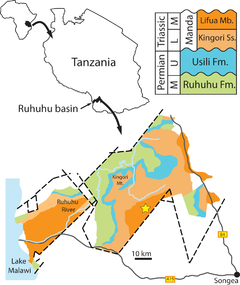| Usili Formation | |
|---|---|
| Stratigraphic range: Lopingian ~ | |
 | |
| Type | Geological formation |
| Unit of | Songea Group |
| Underlies | Manda Formation |
| Overlies | Ruhuhu Formation |
| Thickness | 260 m (850 ft) |
| Lithology | |
| Primary | Sandstone, conglomerate |
| Other | Siltstone, mudstone |
| Location | |
| Coordinates | 10°18′S 35°06′E / 10.3°S 35.1°E |
| Approximate paleocoordinates | 55°06′S 15°12′E / 55.1°S 15.2°E |
| Region | Ruvuma Region |
| Country | |
| Extent | Ruhuhu Basin |
| Type section | |
| Named for | Usili Mountain |
| Named by | Stockley |
| Year defined | 1932 |
The Usili Formation is a Late Permian geologic formation in Tanzania. It preserves fossils of many terrestrial vertebrates from the Permian, including temnospondyls, pareiasaurs, therapsids and the archosauromorph Aenigmastropheus.[1][2]
- ^ Sidor, C. A.; Vilhena, D. A.; Angielczyk, K. D.; Huttenlocker, A. K.; Nesbitt, S. J.; Peecook, B. R.; Steyer, J. S.; Smith, R. M. H.; Tsuji, L. A. (2013). "Provincialization of terrestrial faunas following the end-Permian mass extinction". Proceedings of the National Academy of Sciences. 110 (20): 8129–33. Bibcode:2013PNAS..110.8129S. doi:10.1073/pnas.1302323110. PMC 3657826. PMID 23630295.
- ^ Ezcurra, M. N. D.; Scheyer, T. M.; Butler, R. J. (2014). "The Origin and Early Evolution of Sauria: Reassessing the Permian Saurian Fossil Record and the Timing of the Crocodile-Lizard Divergence". PLOS ONE. 9 (2): e89165. Bibcode:2014PLoSO...989165E. doi:10.1371/journal.pone.0089165. PMC 3937355. PMID 24586565.
